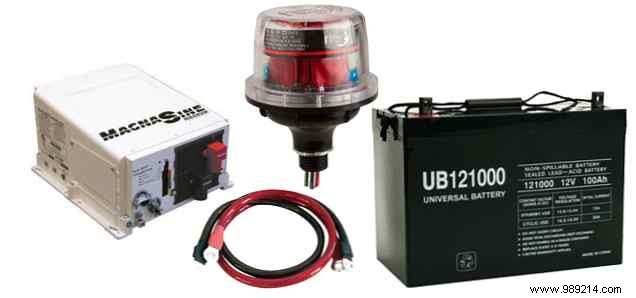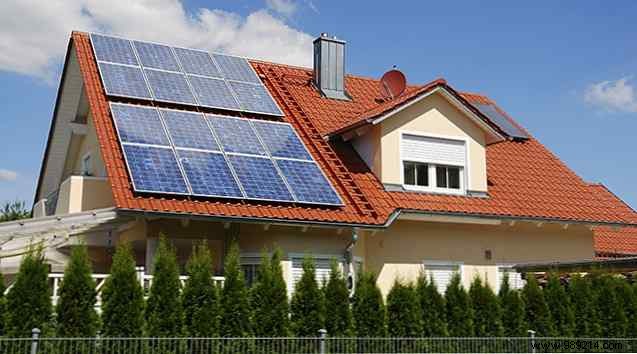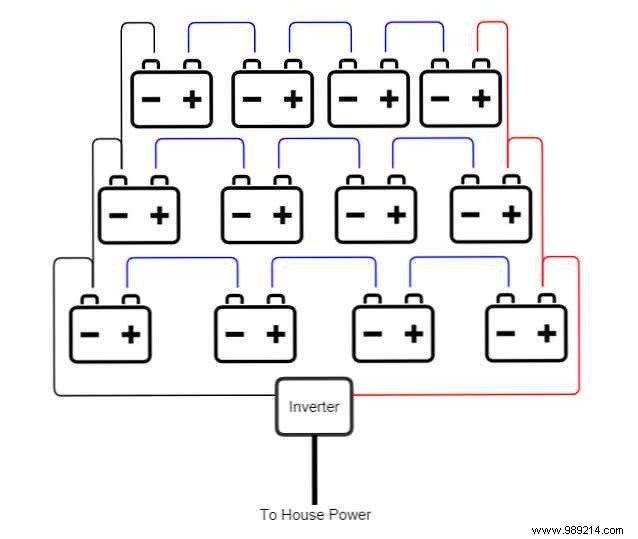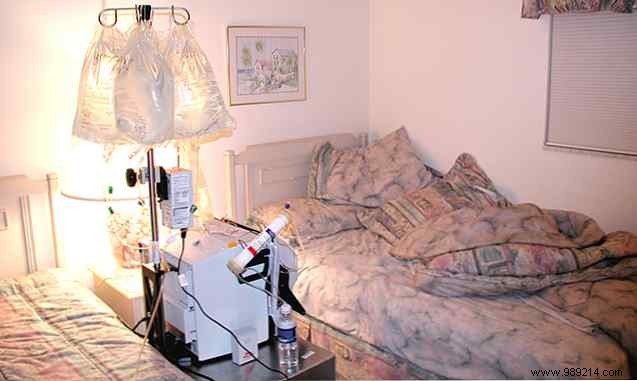One day, you were sitting in your office and the power went out. But your computer kept working because it has an uninterruptible power supply or UPS. A thought crossed your mind. "That was cool. I wonder if I could put my whole house on a UPS?”
Yes. Yes you can. It might even be less expensive than you think. We'll cover the basics, but a system like this should be installed by a qualified electrician. Stick with it until the end and we'll see how you can plan for this system, and also save some money.
The concept is simple. Have several batteries connected to form one large battery, more appropriately called a battery bank. Tesla's battery could change the world, but does it actually save you money? Tesla's battery could change the world, but does it actually save you money? Innovation has a cost. One of the hopes in energy innovation is that there will eventually be a financial payoff. Tesla's battery is no different. Read more or matrix. Have a way to connect that bank to your home power supply to keep the bank fully charged. Then have a way to use the power from the bank when it goes out. Top 10 activities to do when there is a power outage. Top 10 activities to do when there is a power outage. Read More. Simple truth? Yes, it's simple, but is it easy? Could be.
The hardware required to create this battery backup is not much. You will need batteries, an inverter Road Warriors:The Essential Gadgets Road Warriors:The Essential Gadgets Read More Of course, there are other small parts, but this is just an introduction to the system. It is best to have a qualified electrician install this. Consider this a primer so you better understand what your electrician is saying.

When it comes to finding an electrician, try to find one with a lot of experience in this kind of thing. Battery backup and grid-tied power systems What is solar power and why hasn't it been phased out? What is solar energy and why hasn't it been removed? What is the problem with solar energy? If it really is as important and necessary as many claim, why hasn't it taken over the energy industry yet? Read More In fact, see if you can find someone who is NABCEP certified first. NABCEP is the North American Board of Certified Energy Professionals. Don't be afraid to ask for references and go check out some of his other work.

If this sounds like something you want to do, the next thing to figure out is the specs for all the parts needed. This depends on the details about your appliances. It also depends on how you currently use electricity. 5 Smart Hacks to save electricity in your smart home. 5 Smart Hacks to save electricity in your smart home. The trick to saving electricity is to know where most of your energy is consumed. Read more . The final piece is how long you want to back up when the power goes out.
You need to find out a few things about how your home and your appliances use electricity. What you are calculating is the usage in kilowatts, (kWh), watts (W), and amps (A) of all the appliances and devices in your home. You may want to start typing these numbers. They will help you a lot when you start this project and are useful for many other energy saving projects. 3 Alternative energy projects for the home that could reduce your electric bill. 3 Alternative energy projects for the home that could reduce your electric bill. Let's see how. We can take on some simple alternative energy projects and save tons of money. Read more . Since houses vary widely around the world, let's base the calculations in this article on a sample house. In previous articles, we have used a square meter of 1,600 square feet. home located somewhere in the northeastern United States where energy use is highest in January.

The easiest way to figure out how many kWh your home uses in a day is to look at your energy bills. Find the bill with the highest electricity usage. If you are in the north, it will probably be from the first three months of the year. If you are in the south, it will probably be in the peak summer months. Your bill should tell you what your average daily electricity usage is for that period. That will be in kWh and is a key number for this project. The average daily electricity consumption for this house in January is 38kWh.
You'll also want to know how many watts your appliances are using at one time. There are a few ways to resolve this. You can get the nameplate information of your devices, write it all down, and then add it. But many devices do not have a proper nameplate with all the information. The most accurate would be to get a device like the Kill A Watt EZ Electricity Usage Monitor. The example home appliances and devices would consume approximately 4400W (or 4.4kW).
P3 International P4460 Kill A Watt EZ Electricity Usage Monitor P3 International P4460 Kill A Watt EZ Electricity Usage Monitor Buy Now On Amazon $26.29
The inverter is the device that will take direct current (DC) electricity from your batteries and convert it to the alternating current (AC) used by the appliances in your home. Its capacity is measured in watts and volts. You will want an inverter that has the ability to charge your batteries as well. Because your home is still connected to the power grid, your inverter must be able to safely connect to the grid. These types of inverters have the ability to automatically detect when utility power drops and switch to batteries. That function is known as an AC automatic transfer switch.
The important number for sizing the inverter is watts. The home example takes about 4.4 kW. You may want an investor rated higher than that...but not too much. The bigger they are, the more expensive they are..
The next important number is the battery bank voltage (VDC). This means the voltage coming from your battery bank to the inverter. How do you realize that? A good rule of thumb is to add 12 VDC for every 1000 watts of AC power you'll need. We know we need 4400W. At just over 4,000W you can see you'll need 4 X 12VDC. So a 48VDC system is probably best.
Now we know we need a 4.4 kW (or 4400W) 120VAC inverter 48VDC charger. It's a mouthful, but it gives you a good starting point to look for one. Something like the Magnum 4400W inverter/charger should work.
Magnum Energy MS4448PAE MS-PAE Series 4400W 48VDC Pure Sine Inverter Charger; Provides multiple ports, including an RS485 communication port for network expansion, and a remote port Magnum Energy MS4448PAE MS-PAE Series 4400W 48VDC Pure Sine Inverter Charger; Provides multiple ports, including an RS485 communication port for network expansion and a remote port Buy Now On Amazon $1,815.16
A battery bank is just a collection of batteries that are connected together. It is the battery bank that will determine how long your house can run while the power grid is off. So you need to figure out how long you want that to be. Take stock of outages in your area in recent years. What is the longest haircut you've ever had? Was it an abnormally long time like a few weeks due to a hurricane Free storm tracking software to be warned before everyone else Free storm tracking software to be warned before everyone else Read More Try not to count that in your calculations. Battery backup for a few weeks will require charging of the solar panels. 6 Advantages of Solar Panels You Probably Haven't Considered 6 Advantages of Solar Panels You Probably Haven't Considered Solar energy is becoming more common among middle-class consumers, with more and more people realizing the advantages of panels. solar. Read More At that point, just consider going off-grid.

Most people only have a power outage for a few hours... Perhaps you are in a very rural area where it usually takes a day or two for service crews to arrive. Maybe you live in the city and have never had a blackout of more than 4 hours. Events like Hurricane Sandy Free storm tracking software gets a warning before everyone else Free storm tracking software gets a warning before everyone else Read More cover for a couple of weeks would be ridiculously expensive. Try not to count exceptions like that in your estimate.

The example house is in a city, so let's say it is never without power for more than 4 hours. But you're cautious, so we're going to use 6 hours to build a safety margin. Let's see how many kWh you need to cover 6 hours. Divide the daily kWh used by 24 to get the kWh per hour used. Then multiply that by the number of hours you need to back up. 38kWh divided by 24 gives us 1.58 kWh. Multiplied by 6 hours gives us 6.33kWh..
(KWh daily / 24h) / Need for backup in hours =Total kWh needed
Batteries should not be depleted more than 50% in this type of system. That means you'll need double the kWh, so that becomes 12.7kWh. However, the inverters are not 100% efficient, so you will lose a percentage of that 12.7kWh to the inverter. Inverter efficiencies vary, but 85% efficiency is a reasonable number to work with. To get your final number, add 15%. ineffectiveness to your kWh to get 14.9 kWh. Let's call it 15kWh for easier math. Here is the full formula for this calculation:
Minimum kWh X 1.15 =total kWh
The last number we need is the ampere hour (Ah). To achieve that, divide the total kWh (12.7kWh) by the desired battery system voltage. You realized that it would be 48VDC.
Total kWh / VDC del banco de baterías =Ah
Sus horas de amplificador serán 12700Wh divididas por 48VDC. Eso te da 265Ah. Ahora sabe que necesita un banco de baterías que le dará 265Ah a 48V. Entonces, ¿cuántas baterías necesitará y cómo se configurarán? Eso depende de las clasificaciones de voltaje y amperios / hora de las baterías que desea utilizar. Para este ejemplo, usemos baterías de ciclo profundo de 12V 100Ah. Son comunes, fáciles de manejar y cuestan alrededor de $ 200 cada uno..
Mighty Max Battery 12V 100AH DEEP Cycle VRLA Solar Wind Battery 12V 24V 48V Brand Product Mighty Max Battery 12V 100AH DEEP Cycle VRLA Solar Wind Battery 12V 24V 48V Brand Product Buy Now On Amazon $174.99
Con este tipo de batería, necesitará 12 de ellas, lo que le costará al menos $ 2400. Tendrás 3 grupos de 4 baterías cableadas en serie. Los 3 grupos serán conectados en paralelo. Esto realmente te dará 48V y 300Ah. El siguiente diagrama muestra cómo se verá eso.

Hay una herramienta de diseño de banco de baterías simple en FreeSunPower.com. Vaya y pruebe diferentes configuraciones de baterías, voltajes del sistema y horas de amperaje para ver qué otras opciones puede tener.
“Parece que esto es bastante caro.”, Crees. Yes it is. El sistema del que hemos hablado anteriormente sería de alrededor de $ 6500 para instalar. Para la capacidad de ejecutar dispositivos médicos necesarios, podría valer la pena. Si vives en un condominio o tienes una asociación de propietarios de viviendas donde no puedes manejar un generador de gas, podría valer la pena. Pero solo para asegurarte de tener algo de energía en un apagón?

Se puede hacer más barato. La clave es ser estricto con respecto a los dispositivos y dispositivos que realmente necesita durante un apagón. Eliminar las cargas no esenciales podría reducir su costo de instalación a la mitad. Si puede reducir sus necesidades de energía, puede considerar obtener un generador de energía solar. Generadores solares frente a generadores de combustible:¿Cuál es el mejor para usted? Solar Generators vs Fuel Generators:Which is Best for You? Would a solar generator make more sense than a gas generator? What solar generator options are there? Those are the questions we will look at today. Lea más como el generador VSP de 3500 vatios por alrededor de $ 3,300. La ventaja de este sistema es que puede seguir cargando incluso cuando no hay electricidad..
Generador de energía solar:generador de 3500 vatios VSP con panel de cargador solar de 200 vatios Generador de energía solar:generador de 3500 vatios con panel de cargador solar de 200 vatios VSP Compra ahora en Amazon
Recorte lo suficiente e incluso podría salirse con la suya con solo necesitar una solución de respaldo de batería autónoma, como el generador de inversor portátil Energizer de 2200 vatios por alrededor de $ 600.
PSC2200, 2000 Vatios de funcionamiento 2200 vatios pico, generador de inversor de energía silencioso, portátil, de 4 tiempos, compatible con CARB PSC2200, 2000 vatios de funcionamiento, 2200 vatios de pico, silencioso generador de inversor portátil de energía de gas de 4 tiempos, compatible con CARB Compre Ahora En Amazon $ 696.42
El punto importante es que puede alimentar su hogar con baterías durante un apagón. Armado con lo que ha aprendido aquí, puede continuar investigando la mejor manera para usted con un mayor grado de comprensión. But be careful! Una vez que se dé cuenta de que podría salir de la red por completo, podría desarrollar un nuevo estilo de vida energético 7 Tecnologías de ahorro de energía para reducir la huella de carbono de su hogar 7 Tecnologías de ahorro de energía para reducir la huella de carbono de su hogar Las siguientes tecnologías de ahorro de energía pueden ser Introducido en nuestros hogares para reducir nuestro impacto ambiental. Not all of them will be affordable just yet, but we expect all of them to become the norm in the near future. Read more !
¿Qué piensas acerca de construir un sistema de este tipo en tu propia casa? ¿Contratarás a un electricista para que te construya uno? ¿Alguna vez has construido uno? Comparte tus propias experiencias en la sección de comentarios a continuación.!